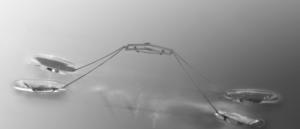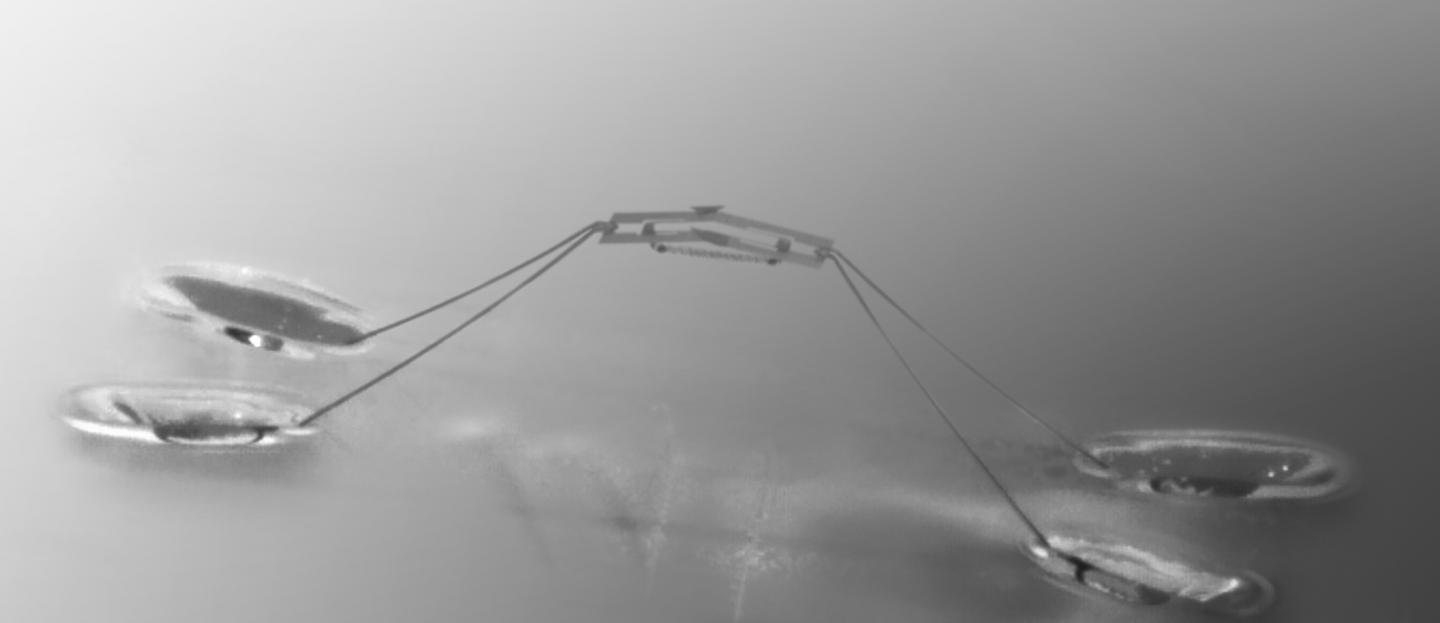
Credit: Seoul National University
Whether Jesus walked on water or not is a leap of faith. But there are small living creatures that take advantage of the water’s surface tension to work their way around.
Consider the case of the water striders, a species of semi-aquatic insects that not only skim along the water’s surface but also generate enough upward thrust with their legs to jump on the water. There’s also the Jesus Lizard (generic name Basiliscus, and common name basilisk) that gets its name from its ability to run across water for significant distances before sinking.
Having studied the natural form of water-based locomotion of the water strides, an international team of scientists from Seoul National University, Korea (SNU), Harvard’s Wyss Institute for Biologically Inspired Engineering, and the Harvard John A Paulson School of Engineering and Applied Sciences, unveiled a robotic insect that can jump off the water’s surface. Their research was reported in the 31 July issue of Science.
The team watched the water strider jump on water surfaces using high-speed cameras. They noticed that the long legs accelerate gradually, so that the water surface doesn’t retreat too quickly and lose contact with the legs.
Using a theoretical model of a flexible cylinder floating on liquid, the authors found that the maximum force of the water striders’ legs is always just below the maximum force that water surface tension can withstand.
To recreate this controlled acceleration when building their robot, the researchers used a torque reversal catapult (TRC) mechanism that generates a small initial torque and gradually increases–but never exceeds the surface tension force of water.
The high-speed cameras also revealed that the water strider sweeps its legs inward to maximize the time the legs can push against the surface of the water, thus maximizing the overall force. This was applied to the robots to help them achieve lift-off. With sufficiently light weight, long limbs, and the proper physical mechanisms, these robots effectively mimic their inspirational counterparts in nature.
Mimicking these mechanics, the robotic insect built by the team can exert up to 16 times its own body weight on the water’s surface without breaking through, and can do so without complicated controls.
“If you apply as much force as quickly as possible on water, the limbs will break through the surface and you won’t get anywhere,” said Robert Wood, Ph.D., a co-author on the study, in a statement on 30 July. He is a Wyss Institute core faculty member, the Charles River Professor of Engineering and Applied Sciences at the Harvard Paulson School, and founder of the Harvard Microrobotics Lab.
“Using its legs to push down on water, the natural water strider exerts the maximum amount of force just below the threshold that would break the water’s surface,” corroborated the study’s co-first author Je-Sung Koh, Ph.D., who was pursuing his doctoral degree at SNU during the majority of this research. He is now a post-doctoral Fellow at the Wyss Institute and the Harvard Paulson School.
Bio-inspired robots have been in the works for quite a few years.
Snake bots, aerial vehicles and rovers today search for and rescue survivors from debris caused by earthquakes, especially from areas humans can’t reach. These robots also have names. Quince, for instance, is being deployed to sense chemical, biological, radiological or nuclear dangers. Developed by the Chiba Institute of Technology and Tohoku University, it has a camera, microphone, position sensitive detector (PSD) sensor, laser range finder, Wi-Fi and infrared thermography camera and carbon-dioxide sensors to locate survivors by detecting body heat and breathing. It can move on its wheels at about 5.2 feet per second.
India’s Defence Research and Development Organisation (DRDO) has its own “Sanjeevani” (meaning ‘life giver’) for similar situations, the initial version of which was used to detect survivors after the Gujarat earthquake in 2002. Available as a portable pack, the robot’s probe head can be used in air, water or mud.
‘Assistive’ robots are similar to the ones which help humans in cleaning rugs like Roomba, washing windows or minimizing human accidents by doing dangerous, repetitive tasks on industrial shop-floors. Another category of ‘social’, humanoid (even androids) robots behave more like humans. Some even serve as human companions like eldercare bots and nanny bots. And there have been talks about “marrying robot companions” too.
To be categorized as “social”, these robots need autonomy–they should not be remote-controlled. Examples include Kismet, Leonardo, Maggie, Domo, Mertz, AIBOs, Furbies, Cog and Paros. Honda’s ASIMO, also referred to as a humanoid robot, even celebrated its 10th birthday on 31 October 2010.
But robots have a long way to go before they compete successfully with humans, especially when dealing with hazardous situations.
For instance, even at the biggest and most well-funded international robotics competition by Defense Advanced Research Projects Agency (DARPA), an agency under the US department of defence, the robots failed to live up to human expectations.
Held this June, the global competition encouraged designing of robots that can perform dangerous rescue work after nuclear accidents, earthquakes and tsunamis. To qualify for the DARPA Robotics Challenge (DRC) finals, the teams had to demonstrate that their robots can engage an emergency shut-off switch, get up from a prone position, walk for 10 metres without falling, pass over a barrier and rotate a circular valve 360 degrees.
The robots were tested for their ability to open doors, turn valves, connect hoses, use hand tools to cut panels, drive vehicles, clear debris and climb a stair ladder. However, all these tasks that are relatively simple for humans, continue to pose a lot of difficulty to robots.
To be sure, the difficulties are not unsurmountable and robots will eventually become much smarter and very powerful with the infusion of artificial intelligence (AI).
That could pose a major challenge too, because while human beings have a sense of right and wrong and can take moral decisions, that may not be the case with autonomous robots if humans are kept out of the loop. There’s the fear that it could lead to indiscriminate killings, especially on battlefields. Moreover, if humans err in judgement, they can be pulled up by the courts. They can be punished. But what does one do with autonomous robots, unless states evolve some legislation?
This line of thinking is central to any discussion on autonomous robots even as the thought of replacing robots in a war-like situation to have fewer human casualties remains an attractive proposition.
This is also the primary reason why over 1,000 artificial intelligence (AI) researchers, scientists, and related professionals signed an open letter issued in Buenos Aires on 28 July, calling for a ban on autonomous weapons that select and engage targets without human intervention, thereby swelling the ranks of the rapidly growing global movement to address the weapons.
The letter was presented on 28 July at the International Joint Conference on Artificial Intelligence in Buenos Aires, Argentina.
The signatories to the letter included Tesla chief executive Elon Musk, Apple Inc co-founder Steve Wozniak, Google Inc DeepMind chief executive Demis Hassabis, Skype co-founder Jaan Tallin, Professor Stephen Hawking, and Professor Noam Chomsky.
